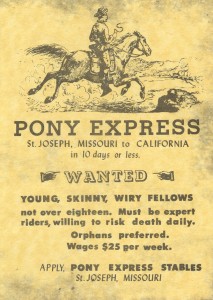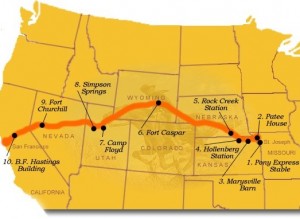sacramento
 With this year marking the 155th anniversary of the Pony Express, there is much celebration in the arena of those who love to celebrate the history of the Pony Express. Every year the first couple of weeks in June find many riders marking the amazing accomplishments of the Pony Express by riding the route once again. The riders follow the original route from Saint Louis, Missouri to Sacramento, California. They travel on horseback, just as the original riders did, and they ride 24 hours a day, just as the riders before them. Today, June 20, 2015 puts them traveling through the state of Wyoming. They left Atlantic City, Wyoming June 20, 3:00am, Farson, Wyoming at 9:00am, Green River Crossing at 11:00am, Granger, Wyoming at 12:30pm, Uinta County Line at 1:00pm, Fort Bridger, Wyoming at 4:00pm, and cross the Wyoming/Utah state line at 9:00pm, arriving in This Is The Place Heritage Park in Utah in time to depart on Sunday, June 21, 3:30am, to continue on to their destination of Sacramento, California with a planned arrival at Old Sacramento, California on Thursday, June 25, 11:30am.
With this year marking the 155th anniversary of the Pony Express, there is much celebration in the arena of those who love to celebrate the history of the Pony Express. Every year the first couple of weeks in June find many riders marking the amazing accomplishments of the Pony Express by riding the route once again. The riders follow the original route from Saint Louis, Missouri to Sacramento, California. They travel on horseback, just as the original riders did, and they ride 24 hours a day, just as the riders before them. Today, June 20, 2015 puts them traveling through the state of Wyoming. They left Atlantic City, Wyoming June 20, 3:00am, Farson, Wyoming at 9:00am, Green River Crossing at 11:00am, Granger, Wyoming at 12:30pm, Uinta County Line at 1:00pm, Fort Bridger, Wyoming at 4:00pm, and cross the Wyoming/Utah state line at 9:00pm, arriving in This Is The Place Heritage Park in Utah in time to depart on Sunday, June 21, 3:30am, to continue on to their destination of Sacramento, California with a planned arrival at Old Sacramento, California on Thursday, June 25, 11:30am.
The Pony Express is one of the few services that achieved so much recognition in such a short history. The service opened officially on April 3, 1860, when riders left simultaneously from St. Joseph, Missouri, and Sacramento, California. The first westbound trip was made in 9 days and 23 hours and the eastbound journey in 11 days and 12 hours. The pony riders covered 250 miles in a 24-hour day. Eventually, it gre to more than 100 stations, 80 riders, and  between 400 and 500 horses. Their delivery record was amazing in that during their run, only one mail delivery was lost. The service lasted only 19 months until October 24, 1861, when the completion of the Pacific Telegraph line ended the need for its existence.
between 400 and 500 horses. Their delivery record was amazing in that during their run, only one mail delivery was lost. The service lasted only 19 months until October 24, 1861, when the completion of the Pacific Telegraph line ended the need for its existence.
While it’s time was short, the Pony Exoress has become a beloved historic icon. In fact, in many ways, the service the Pony Express provided, makes our current mail service pale by comparison. I realize that there are many very good mail service workers, but there are also many who couldn’t care less about the mail they deliver, or the people sending or receiving it. They are, unfortunately, among the sorry generation of people who think a paycheck shouldn’t necessarily depend on the work performed, or not performed. That mentality was totally foreign to the Pony Express riders, who risked their very lives every day to make sure that communication in this great nation was possible. Happy 155th Anniversary to the Pony Express.
 I often wonder how it must have felt to live in a time when so many things were changing in ways that man had not seen before. Things like the automobile, the airplane, the light bulb, the telephone, and the telegraph, all came into being between the 1800s and the early 1900s. Prior to these things, our world was rather primitive concerning things like travel, communication, and even the home life…at least by today’s standards, anyway.
I often wonder how it must have felt to live in a time when so many things were changing in ways that man had not seen before. Things like the automobile, the airplane, the light bulb, the telephone, and the telegraph, all came into being between the 1800s and the early 1900s. Prior to these things, our world was rather primitive concerning things like travel, communication, and even the home life…at least by today’s standards, anyway.
When families began moving West to find land and adventure, it was often a very sad time, because many of these people would not see their loved ones again. They might not even hear from them. This really seemed like an unacceptable situation for most of the people on both sides of that spectrum. The people needed to hear from their loved ones, and so like every other idea, from necessity came a solution…the Pony Express. Prior to the Pony Express, people might try to send a letter with a wagon train heading West to see of they could manage  to get it to a loved one who had left a year or more before. Imagine the impossibility of that feat. The person with whom the letter was sent, might not even know the person to whom the letter was being sent. It meant asking around in the area they had planned to settle in, and if they had moved elsewhere…well that is the real definition of the dead letter.
to get it to a loved one who had left a year or more before. Imagine the impossibility of that feat. The person with whom the letter was sent, might not even know the person to whom the letter was being sent. It meant asking around in the area they had planned to settle in, and if they had moved elsewhere…well that is the real definition of the dead letter.
The Pony Express became the first dedicated postal service ever, on this day, April 3, 1860, but it was a far cry from the mail service of today, about which many of us complain. The men who chose to be Pony Express riders had to be told about what they might be riding into. There were Indians, who did not like the White Man. Treaties had been broken, and the White Man was considered an intruder on Indian land. To say that the White Man was not welcome in the West, was putting it mildly. Every time the Pony Express rider set out, he was taking on the risk of never coming back. The Help Wanted posters clearly stated the dangers, and the riders had to be single young men preferably under eighteen and preferably orphans!! Not a glowing help wanted ad, for sure, still there was a need, and these brave men took the challenge and made it work. The Pony Express was a short lived phenomenon, however, lasting just eighteen short months. I suppose something had to be done to make mailing a letter safer. At the point when the last Pony Express rider rode his route, the telegraph had somewhat  taken its place. Most what had been needed was to be able to let people about the death of loved ones and other urgent or important news, so it seemed like an unnecessary risk to place on these men, when a safe way had been found.
taken its place. Most what had been needed was to be able to let people about the death of loved ones and other urgent or important news, so it seemed like an unnecessary risk to place on these men, when a safe way had been found.
The first Pony Express rider to make the run has been a matter of dispute, but historians have narrowed it down to Johnny Fry or Billy Richardson. James Randall was credited with being the first Eastbound rider, heading out from San Francisco to Sacramento, and William (Sam) Hamilton took the mail from there to the Sportsman Hall Station, where he handed it off to Warren Upson. Other riders were Gus and Charles Cliff, Robert Haslam, Jack Keetley, Billy Tate, and the famous William Cody, known to most of us as Buffalo Bill. Together, these men rode into history as some of the bravest men who ever lived. Riding alone through dangerous territory, risking their lives to make life a little easier for the ever expanding nation we lived in.

